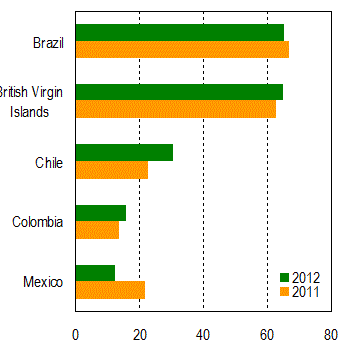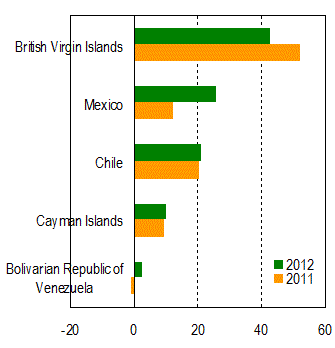A 17 per cent drop in foreign direct investment (FDI) inflows to Central America and the Caribbean in 2012 masked an increase of 12 per cent to South America during the year, UNCTAD’s World Investment Report 20131 reveals.
These shifting fortunes resulted in a 2 per cent decline as a whole for the region of Latin America and the Caribbean.
The World Investment Report 2013 subtitled Global Value Chains: Investment and Trade for Development, was released today.
Total FDI to the region in 2012 was US$244 billion, the report reveals. Flows into Central America and the Caribbean came to $99 billion, and FDI directed to South American countries reached $144 billion.
Factors keeping South America as an attractive target for FDI are its wealth in oil, gas and minerals, and its fast-expanding middle class that draws market-seeking investment, the report says.
The growth in FDI to South America took place despite a slowdown in the subregion’s main recipient, Brazil (-2 per cent to $65 billion), after two years of high growth. In 2012, FDI growth was driven by countries such as Chile (+32 per cent to $30 billion), Colombia (+18 per cent to $16 billion), Argentina (+27 per cent to $13 billion) and Peru (+49 per cent to $30 billion), which were, in that order, South America’s main recipient countries in 2012 after Brazil.
Central America and the Caribbean, excluding the offshore financial centres, saw a 20 per cent decrease in FDI to $25 billion, owing to a 41 per cent drop in investment into Mexico to $12.6 billion, the report notes. FDI to the region’s offshore financial centres decreased by 16 per cent to $74 billion. However, that total remains higher than the level reached before the global financial crisis.
Cross-border mergers and acquisitions (M&As) sales in 2012 increased by 5 per cent to $21 billion, with an important shift in the origin of the purchasers, the report says. Developing-country-based transnational corporations (TNCs) continued to increase their acquisitions in 2012 – they climbed by 26 per cent. These acquisitions mainly involved intraregional sources (firms based in such countries as Argentina, Brazil, Chile and Colombia), while developed-country TNCs sold more assets than they acquired. In particular, debt-strapped European companies sold assets to raise cash, as in the case of Banco Santander (Spain) which sold a 95 per cent stake in its Colombian unit to CorpBandca (Chile) for about $1.2 billion so that Santander could focus on its core business and markets.
Outward FDI from Latin America decreased by 2 per cent to $103 billion in 2012, with uneven growth among countries, the report reveals. However, these data do not reflect the dynamism of Latin American TNC activity abroad, as shown by a 74 per cent increase in their cross-border acquisitions in 2012, to $33 billion, the report notes. Increasing acquisitions abroad by Latin American TNCs is a trend that began in 2006, reached its peak in 2007, and was halted by the global financial crisis before resuming in 2010. From 2010 to 2012, Latin American companies spent a net $66 billion acquiring companies abroad. Buoyant conditions at home, cash-rich balance sheets, and saturated domestic markets have encouraged these TNCs to seek new opportunities abroad, the report notes. At present, these acquisitions are mostly in Latin America and developed countries, more or less in equal measure.
The World Investment Report says that FDI into South America remains focused on the extractive industries, with foreign companies playing the dominant role except in the case of Brazil. FDI in this sector is growing important in some countries, the report says. For example in Colombia, the share of the extractive industry in FDI stock stood at 26 per cent in 2002, however this industry attracted 53 per cent of total FDI flows between 2003 and 2012. In Chile, the share of the extractive industry in FDI stock increased from 27 to 39 per cent between 2006 and 2011, while in Peru, it increased from 14 per cent in 2001 to 27 per cent in 2011. Only Argentina witnessed a decline in the share of the extractive industry in total FDI stock during the second half of the 2000s, from 40 per cent in 2005 to 31 per cent in 2011. Increases in shares of the extractive industry in FDI in certain countries in South America are in line with the increasing importance of this industry in exports and value added.
New policy measures were undertaken in 2012 in Brazil in the context of its new industrial, technological, and foreign trade policy inaugurated in 2011. The policy includes a mixture of fiscal incentives, loans at preferential rates from the Brazilian Development Bank (BNDES), and tax relief. In particular, a new regime (Inovar-Auto) was approved to encourage investments in vehicle efficiency, national production, research and development, and automotive technology. Partly as a result, FDI to the automobile industry (assembly and auto parts) jumped from an annual average of $116 million in 2007–2010 to an average of $1.6 billion for 2011–2012.
Similarly, “nearshoring” to Mexico is picking up momentum, the report says, as more manufacturing companies seek ways to reduce costs and bring products into the United States market more quickly by operating closer to it. The report says that this trend is due to the rapid growth of labour costs in China – the largest offshoring location – and to rising and volatile fuel costs that have made the shipping of goods across the Pacific less financially attractive. Companies that have moved some or all of their production in recent years from Asia to Mexico in order to be closer to the United States include Emerson (electrical equipment) and Axiom (fishing rods).
Figure 1. Top 5 recipients of FDI in Latin America and the Caribbean, 2011 and 2012
(billions of dollars)
Source: UNCTAD, World Investment Report 2013.
Figure 2. Top 5 investors from Latin America and the Caribbean, 2011 and 2012
(billions of dollars)
Source: UNCTAD, World Investment Report 2013.



